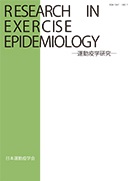Volume 18, Issue 2
Displaying 1-10 of 10 articles from this issue
- |<
- <
- 1
- >
- >|
Preface
-
2016Volume 18Issue 2 Pages 66-
Published: September 30, 2016
Released on J-STAGE: December 21, 2019
Download PDF (212K)
Original Article
-
2016Volume 18Issue 2 Pages 67-75
Published: September 30, 2016
Released on J-STAGE: December 21, 2019
Download PDF (453K) -
 2016Volume 18Issue 2 Pages 76-87
2016Volume 18Issue 2 Pages 76-87
Published: September 30, 2016
Released on J-STAGE: December 21, 2019
Download PDF (742K)
Practice Article
-
2016Volume 18Issue 2 Pages 88-98
Published: September 30, 2016
Released on J-STAGE: December 21, 2019
Download PDF (800K) -
2016Volume 18Issue 2 Pages 99-104
Published: September 30, 2016
Released on J-STAGE: December 21, 2019
Download PDF (541K) -
2016Volume 18Issue 2 Pages 105-112
Published: September 30, 2016
Released on J-STAGE: December 21, 2019
Download PDF (622K)
Secondary Publication
-
2016Volume 18Issue 2 Pages 113-121
Published: September 30, 2016
Released on J-STAGE: December 21, 2019
Download PDF (501K) -
2016Volume 18Issue 2 Pages 122-136
Published: September 30, 2016
Released on J-STAGE: December 21, 2019
Download PDF (819K)
Other Article
-
2016Volume 18Issue 2 Pages 137-142
Published: September 30, 2016
Released on J-STAGE: December 21, 2019
Download PDF (448K)
Official Statement
-
2016Volume 18Issue 2 Pages 143-145
Published: September 30, 2016
Released on J-STAGE: December 21, 2019
Download PDF (382K)
- |<
- <
- 1
- >
- >|
